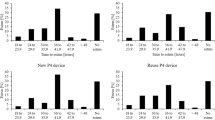Abstract
This study aimed to determine whether reproductive performance of ewes submitted to laparoscopic timed artificial insemination (TAI) would be similar to ante meridiem (AM)/post meridiem (PM) rule and assisted natural mating (NM), and whether GnRH may enhance the pregnancy rate in TAI. In experiment I, 191 non-lactating ewes were synchronized, then TAI was performed either 48 h after progesterone (P4) removal (TAI-48 h) or 12 h after estrus detection (AM/PM); moreover, some ewes were submitted to NM (NM) as control treatment. In experiment II, 247 non-lactating ewes were allocated in five treatments, a control (no-GnRH on protocol) and four treatments arranged in a factorial design 2 × 2. The factors were time and dose of GnRH: ewes that received either 10 μg (TAI-10 μg-36 h) or 25 μg of GnRH (TAI-25 μg-36 h) 36 h after P4 removal and ewes that received either 10 μg (TAI-10 μg-48 h) or 25 μg of GnRH (TAI-25 μg-48 h) at time of insemination, 48 h after P4 removal. In experiment I, pregnancy rate in TAI-48 h was lower (P = 0.03) than AM/PM and NM. Moreover, the probability of pregnancy in TAI-48 h was higher (P = 0.06) in ewes detected in estrus early. In experiment II, the use of GnRH in TAI protocols increased (P < 0.01) pregnancy rate at synchronization, and TAI-25 μ-48 h and TAI-10 μg-36 h treatments increased (P = 0.02) pregnancy rate compered to TAI-10 μg-48 h. We conclude that TAI decreased pregnancy rate compered to NM and AM/PM, which may be improved by GnRH use in TAI to synchronize ovulation.

Similar content being viewed by others
References
Azawi, O.I. and Al-Mola M.K., 2011. A study on the effect of GnRH administration on the ovarian response and laparoscopic intrauterine insemination of Awassi ewes treated with eCG to induce superovulation, Tropical Animal Health and Production, 43, 1351–1355.
Adamiak, S.J., Mackie, K., Watt, R.G., Webb, R. and Sinclair, K.D., 2005. Impact of nutrition on oocyte quality: cumulative effects of body composition and diet leading to hyperinsulinemia in cattle, Biology of Reproduction, 73, 918–926.
Amiridis, G.S. and Cseh, S., 2012. Assisted reproductive technologies in the reproductive management of small ruminants, Animal Reproduction Science, 130, 152–161.
Carvalho, P.D., Souza, A.H., Amundson, M.C., Hackbart, K.S., Fuenzalida, M.J., Herlihy, M.M., Ayres, H., Dresch, A.R., Vieira, L.M., Guenther, J.N., Grummer, R.R., Fricke, P.M., Shaver, R.D. and Wiltbank, M.C., 2014. Relationships between fertility and postpartum changes in body condition and body weight in lactating dairy cows, Journal of Dairy Science, 97, 3666–3683.
De, K., Kumar, D., Sethi, D., Gulyani, R. and Naqvi, S.M.K., 2015. Estrus synchronization and fixed-time artificial insemination in sheep under field conditions of a semi-arid tropical region, Tropical Animal Health and Production, 47, 469–472.
Diskin, M.G. and Morris, D.G., 2008. Embryonic and early foetal losses in cattle and other ruminants, Reproduction in Domestic Animals, 43, 260–267.
Ferraz Junior, M.V., Pires, A.V., Biehl, M.V., Santos, M.H., Barroso, J.P., Gonçalves, J.R., Sartori, R. and Day, M.L. 2016. Comparison of two timed artificial insemination system schemes to synchronize estrus and ovulation in Nellore cattle, Theriogenology, 86, 1939–1943.
Fierro, S., Olivera-Muzante, J., Gil, J. and Viñoles, C., 2011. Effects of prostaglandin administration on follicular dynamics, conception, prolificacy and fecundity in sheep, Theriogenology, 76, 630–639.
Fierro, S., Gil, J., Viñoles, C. and Olivera-Muzante, J., 2013. The use of prostaglandins in controlling estrous cycle of the ewe: a review, Theriogenology, 79, 399–408.
Menchaca, A. and Rubianes, E., 2004. New treatments associated with timed artificial insemination in small ruminants. Reproduction Fertility and Development, 16, 403–413.
Morton, J.M., 2010. Interrelationships between herd-level reproductive performance measures based on intervals from initiation of the breeding program in year-round and seasonal calving dairy herds, Journal of Dairy Science, 93, 901–910.
NRC, 2007. Nutrient requirements of small ruminants: sheep, goats, cervids, and new world camelids. Natl. Acad. Press Washington, DC.
Reyna, J., Thomson, P.C., Evans, G. and Maxwell, W.M.C., 2007. Synchrony of ovulation and follicular dynamics in Merino ewes treated with GnRH in the breeding and non-breeding seasons, Reproduction in Domestic Animals, 42, 410–417.
Ribeiro E.L.A. and González-García, E., 2016. Indigenous sheep breeds in Brazil: potential role for contributing to the sustainability of production systems, Tropical Animal Health and Production, 48, 1305–1313.
Robertson, S.M., Clayton, E.H., Morgan, B. and Friend, M.A., 2015. Reproductive performance in ewes fed varying levels of cut lucerne pasture around conception, Animal Reproduction Science, 158, 75–85.
Sá Filho, M.F., Penteado, L., Reis, E.L., Reis, T.A., Galvão, K.N. and Baruselli, P.S., 2013. Timed artificial insemination early in the breeding season improves the reproductive performance of suckled beef cows, Theriogenology, 79, 625–632.
Sartori, R., Spies, C. and Wiltbank, M.C., 2017. Effects of dry matter and energy intake on quality of oocytes and embryos in ruminants, Reproduction, Fertility and Development, 2017, 29, 58–65.
Acknowledgments
The authors also would like to thank the Fundação de Amparo à Pesquisa do Estado de São Paulo (FAPESP) and the Conselho Nacional de Desenvolvimento Científico e Tecnológico (CNPq) for financial support on this project.
Author information
Authors and Affiliations
Corresponding author
Ethics declarations
Statement of animal rights
The Animal Care and Use Committee from the University of São Paulo approved all procedures with animals.
Conflict of interest statement
The authors declare that they have no conflict of interest.
Rights and permissions
About this article
Cite this article
Biehl, M.V., Ferraz Junior, M.V.C., Ferreira, E.M. et al. Effect of reproductive methods and GnRH administration on long-term protocol in Santa Ines ewes. Trop Anim Health Prod 49, 1303–1308 (2017). https://doi.org/10.1007/s11250-017-1329-1
Received:
Accepted:
Published:
Issue Date:
DOI: https://doi.org/10.1007/s11250-017-1329-1




